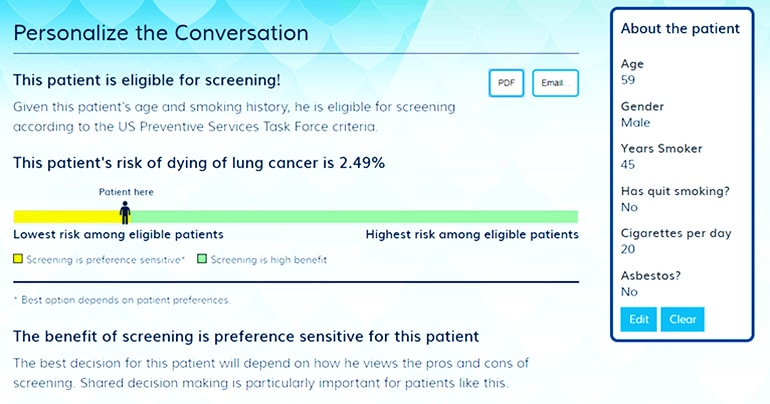A new study could help personalize the lung cancer screening decision for every patient.
The results could help doctors fine-tune their advice to patients, so that it’s based not just on a patient’s individual lung cancer risk and the potential benefits and harms of screening, but also a likely range of patient attitudes about looking for problems and dealing with the consequences.
The study, which appears in the Annals of Internal Medicine, forms the backbone for new free online decision tools aimed at physicians, their teams, and members of the public.
Researchers designed the tool, called Lung Decision Precision, to help clinicians talk with patients and their loved ones about whether to a lung CT scan might be a good idea for them.

The same team has also launched a website for patients and their loved ones that gives easy-to-understand information about the positives and potential negatives of lung cancer screening, and allows individuals to calculate their personal risk of lung cancer.
“Our model is built on a comprehensive view of net benefits for individual patients, which incorporates the best evidence for personalizing the pros and cons of screening and assumes that not all patients will feel the same about screening and its consequences,” explains Tanner Caverly, an assistant professor in the division of general medicine and learning health sciences department at the University of Michigan Medical School.
“This allows us to identify which patients are in the preference-sensitive zone for the decision about screening, and which ones have a very clear potential benefit to them.”
Who needs screening?
Any person with an annual chance of lung cancer between 0.3 percent and 1.3 percent, and a life expectancy of more than 10 years, falls into that latter high-benefit category, he notes. This accounts for about 50 percent of all Americans who qualify for screening under the current guidelines.
But for most of the rest, their personal preferences should play a large role in determining if they should get screened. For instance, this might include how much they dislike getting medical tests in general, how they feel about the potential unintended consequences of looking for a problem when they feel fine, and how they view the process of having to get follow-up scans and lung biopsies if the screening scan shows something suspicious.
“This method can incorporate anything that moves the needle on risk and benefit, and that involves patient preferences about time, dollars, and worry…”
In fact, for them personal preference is more important to their decision than the false-positive rate for lung CT screening (which outnumber true cancers 25 to 1), and the negative impacts of being over-treated for a lung cancer that was not highly dangerous.
At the same time, people who fall into the potential pool of screening candidates but have a short life expectancy and a low risk of lung cancer should not be screened.
The model could help physicians prepare for conversations with patients about lung screening, customized to the patient in front of them.
“If a physician is not clear about the potential benefit for a patient who’s in the high-benefit zone, they could miss an opportunity to do something really good for them, to say, ‘I don’t recommend this for everyone but I recommend it for you,'” Caverly says. “But coming across strong for screening with a patient who has a fine balance of pros and cons could miss an opportunity to give them a choice, to tell them that their decision depends on the kind of person they are.”
Beyond lung cancer
While the study looked specifically at the evidence around lung cancer screening, its authors note that the underlying analytical method could lead to personalized health decision tools for other situations.
The researchers focused on lung cancer—the leading cause of cancer death among both men and women—because of the recent move to encourage certain smokers and former smokers between the ages of 55 and 80 to get screened for it.
A major study published in 2011 showed that some members of this group could survive longer if they had CT screening to find the earliest signs of lung cancer, which is diagnosed in more than 230,000 Americans every year.
Two years later, a national panel recommended it for people between the ages of 55 and 80 who had been or still were heavy smokers (an average of a pack of cigarettes a day for 30 years, who currently smoke or quit less than 15 years ago).
The recommendation comes with exceptions, even among this group, including patients whose overall health meant they have a life expectancy of less than 10 years, and those who aren’t strong enough to withstand lung surgery if a scan shows signs of cancer.
Big data tool predicts best lung cancer treatment
Now, the US Preventive Services Task Force, which made the initial recommendation, is preparing to revisist its guidance on this topic.
Caverly and his colleagues—including senior author Rafael Meza, a professor in the University of Michigan School of Public Health who is coordinating principal investigator of the Cancer Intervention and Surveillance Modeling Network (CISNET) lung group that did the decision modeling supporting the current Task Force recommendations—hope their new study will inform that process.
They’re studying how physicians and the medical team members who assist with screening can use the online tool. They’re also thinking about whether it could be included in the online systems that patients use to communicate with their clinic ahead of an appointment, and the clinical reminder tools that prompt physicians to talk with patients about preventive services that might be right for them.
How it works
The physician-focused tool produces a colorful display that places the individual patient somewhere along a green and yellow line. If a patient is deep in the yellow, they likely have a small but non-zero benefit with screening and screening will depend highly on patient views.
The closer they fall to the divide between green and yellow, the more likely it is that screening will benefit them. And if they’re deep in the green zone, the physician should encourage them more strongly to get screened. The site generates other visual representations, and handouts for patients and their spouse or other loved one.
The team hopes to test the model’s usefulness for other types of health services that many people use and have good data available about their benefits, risks, and patient preferences.
Nose swabs could one day detect lung cancer
This includes cancer screening, disease prevention, chronic disease management approaches, and more.
“This method can incorporate anything that moves the needle on risk and benefit, and that involves patient preferences about time, dollars, and worry,” Caverly explains. “As a clinician I’d like to have this for many of the things I do, where it would be meaningful to know how beneficial something could be for the individual patient, and we could talk about whether it’s indicated for them.”
Additional coauthors of the study are from the VA Ann Arbor Healthcare System. Caverly and coauthor Rodney Hayward are members of the VA Center for Clinical Management research, and received VA funding to develop the web-based tool for providers. Meza and coauthor Pianpian Cao hold funding from the National Cancer Institute.
Caverly is a VA Health Services Research & Development (HSR&D) Career Development Awardee with the VA Center for Clinical Management Research at the VA Ann Arbor Healthcare System.
Source: University of Michigan



